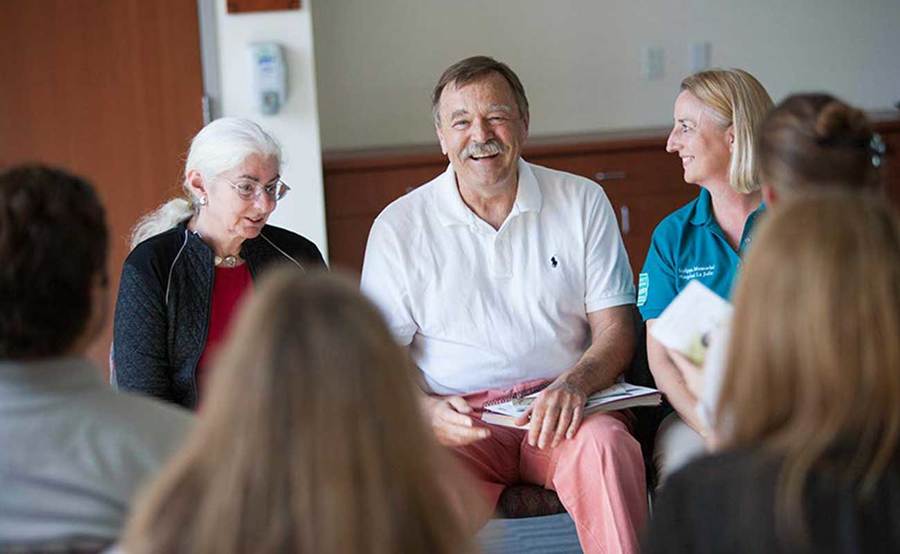Former LVAD Patient Now a Resource for Others
LVAD Ambassador Program provides knowledge and emotional support

Jim Bischoff leads a Scripps LVAD Ambassador Program
support group.
When a patient is debating whether to get a left-ventricular assist device (LVAD), an implanted mechanical heart pump, there’s a lot to consider before undergoing such a major coronary procedure.
Once they decide to go forward with the LVAD, they may have even more concerns along their road to recovery.
That’s where Jim Bischoff comes in. Four years ago Bischoff became the second patient at Scripps to receive an LVAD. After successfully undergoing the procedure, it made sense for the longtime marketing executive to help build awareness of the LVAD program at Scripps and even meet with prospective patients.
“It’s scary — the idea of having this pump put in — and you could just see that having somebody there that had been through it made a difference,” Bischoff says. “After I got comfortable with speaking about it, I realized I was probably getting as much out of these sessions as the patients were.”
Heart failure and transplant
Bischoff certainly has had quite a journey. As a physically active man, it came as a shock when he was diagnosed at age 60 with congestive heart failure in 2005. Bischoff says he was in denial at that time. Even though he noticed he couldn’t work out for quite as long or as hard as he once had, he just didn’t think much about it. That all changed one morning.
“I remember having a feeling I had never felt before,” he says. “You just know something is wrong, and I woke up with my face planted on the concrete.”
Bischoff received a pacemaker at that time, but his health continued to decline. Finally, his cardiologist suggested that Bischoff see Tom Heywood, MD, a specialist in advanced heart failure and transplant, to see if anything else could be done.
Bischoff was given another prescription, but Dr. Heywood wanted to go a bit further.
“He said, ‘You can go home if you want to, but I’d like to check you into the hospital,’" Bischoff recalls. "I was just there to see if I even wanted this guy to be my doctor, so that was quite a shock.”
Luckily for Bischoff, he decided to stick with Dr. Heywood, but the outlook wasn’t good. In fact, Dr. Heywood said he’d be lucky to make it to the end of the year unless something was done.
“I said let’s do it before he even had time to tell me what he was going to do,” Bischoff says. “We were at the point where it was do or die time.”
On Oct. 23, 2012, Bischoff received an LVAD with the idea that the procedure would be a bridge to transplant. He was actually so comfortable following the procedure that Bischoff was fine just continuing to live with the LVAD.
“I was just so happy to be alive,” he says.
Six months later, though, Bischoff’s right ventricle was showing some signs of damage, so heart transplant suddenly became a necessity. Bischoff was added to the heart registry at Cedars-Sinai Medical Center and given 1A status, which put him at the top of the list.
Weeks later in Sept. 2013, he received his new heart — 11 months after receiving the LVAD.
“It takes about a year after the transplant to get back feeling like yourself,” Bischoff says. “It’s rough at first, but I’m back to normal now.”
Role of the Scripps LVAD Ambassador
In addition to meeting with prospective patients as a Scripps LVAD Ambassador, Bischoff would stay with them when they became actual LVAD patients. He would see them go from the ICU to the recovery floor to rehabilitation and when they finally left the hospital.
It was through these visits with patients and their families that Bischoff saw the need for a more formalized LVAD Ambassador Program.
“People have so many questions, not just about the procedure itself but also relationship and emotional kind of questions,” he notes. “I like to get the spouses together when I meet with them, so everyone’s on the same page. This is definitely a two-person thing.”
As he further developed the program, Bischoff began recruiting some patients as new ambassadors.
He says there are three components to being an LVAD ambassador. The first is being a source of information to patients regarding the procedure. The second is to be a cheerleader and offer encouragement, particularly during the ICU phase when a patient can sometimes become discouraged. The third part is to give the patient a little kick during rehabilitation if they need it, and help them get over the last hump.
Although it began as a one-man ambassador program, there are about half a dozen ambassadors now. Having a greater number of ambassadors with recent LVAD patient experience will help ensure there is coverage for each patient as the LVAD program continues to grow.
In fact, Bischoff is looking into possible partnerships with other support groups and would like to develop some formalized training for the program. He’d also like to see an increased focus on how they can better support the caregiver.
“For many people this is an enormous emotional and psychological burden, so that’s one of the things we’re working on," Bischoff says. "We want to build on our experience and make it even better for the patients yet to come.”